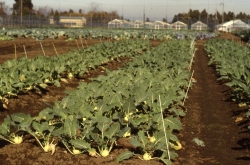Brassica oleracea (Gongylodes Group)
Last revised February 11, 2010
VARIETIES (approximately 55-65 days).
Grand Duke, Kolibri F1 (purple), White Vienna. For trial: Gigante, Granlibakken, Purple Danube, Purple Vienna, Rapidstar, White Danube.

Kohlrabi. Photo credit: Bill Mansour, Oregon State University
SEEDING
All kohlrabi is direct-seeded. Kohlrabi seed numbers approximately 144,000 per pound. Use hot-water and fungicide-treated seed to protect against several serious seed-borne diseases. Hot water seed treatments are very specific (122 F exactly, for 25 to 30 minutes. Seed must then be quickly cooled and dried). The seed treatments are best done by the seed company, and can usually be provided upon request.
Use 1-2 lb seed/acre. Seed in early April to early May or July and August to avoid harvest during the hottest part of the summer since hot weather may produce inferior bulbs. Use only treated seed. Sow the seed 0.5 inches deep.
SPACING
Spacing between rows should range from 12-20 inches. Thin plants to 3-4 inches apart within the row.
FERTILIZER
For the most current advice, see Nutrient Management for Sustainable Vegetable Cropping Systems in Western Oregon, available as a free download from the OSU Extension Catalog
It is recommended to do a soil test for each field to be planted. The following rates are general recommendations only.
Nitrogen: 100-125 (N) lb/acre.
Phosphorus: 100-150 (P2O5) lb/acre, or more, depending on soil test.
Potassium: 100-125 (K2O) lb/acre, or more, depending on soil test.
Magnesium: 15-25 (MgO) lb/acre.
Sulfur: 30-50 lb/acre.
Copper, zinc and boron - as indicated by soil test.
IRRIGATION
Maintain uniform soil moisture for highest quality product. A total of 8-12 inches of water may be needed. Soil type does not affect the amount of total water needed, but does dictate frequency of water application. Lighter soils need more frequent water applications, but less water applied per application.
HARVESTING AND HANDLING
Kohlrabi yield is approximately 120-160 cwt/acre. It is very important to harvest spring-sown kohlrabi when they are small. They will get larger than tennis balls in fair soil, but by this time they are of very poor quality. To get tender, sweet kohlrabi, pick them when they are less than 2-2.5 inches in diameter. Fall-grown kohlrabi is less likely to get woody and may remain at good quality until Christmas when it is 4-5 inches in diameter.
STORAGE (Quoted or modified from USDA Ag. Handbook 66 and other sources)
Store kohlrabi at 32 F and 98 to 100 % relative humidity. Topped kohlrabi should keep for 2 to 3 months if stored under the recommended conditions. Some space between containers for air circulation is desirable, and a high relative humidity is recommended to prevent shriveling and toughening of texture. Packaging in perforated film can be used to reduce moisture loss. Kohlrabi with leaves has a storage life of only 2 weeks at 32 F.
Storage should be at or near 32 F to prevent the development of diseases. Major storage diseases are bacterial soft rot and black rot.
PACKAGING
Kohlrabi is commonly packaged in 25-lb film bags; 50-lb film and mesh bags; or 24-lb cartons, holding 24 film bags, weighing 1 pound each.
